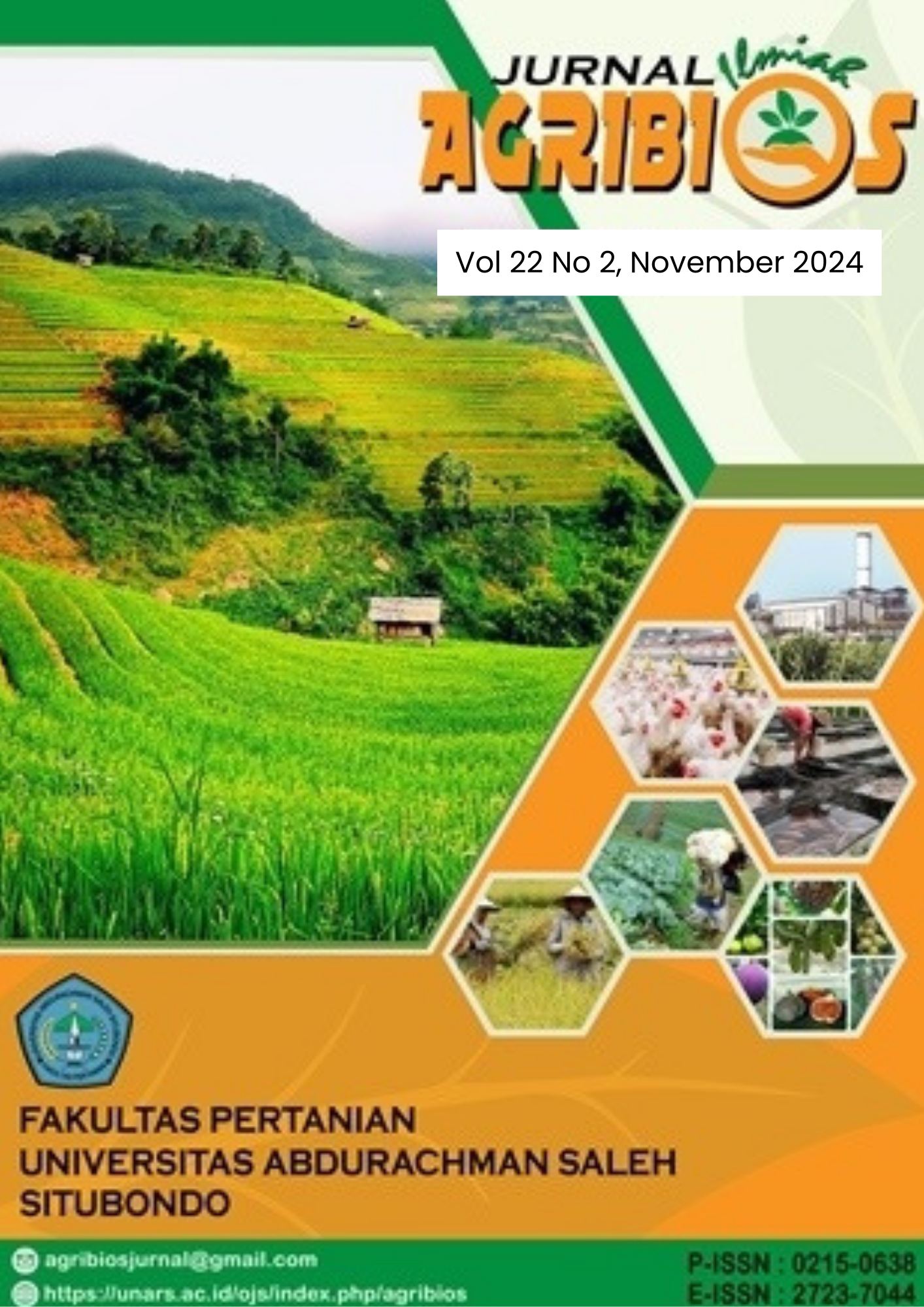RESPON TANAMAN SAWI HIJAU (Brassica juncea L. Var. Tosakan) TERHADAP PEMBERIAN PUPUK ORGANIK DAN AZOTOBACTER PADA TANAH MASAM
Abstract
Acid soils are characterized by low pH (<5.5) and high Al concentration. Organic fertilizers can provide nutrients, can also increase the pH of the soil, and reduce Al levels in the soil. In addition, the addition of Azotobacter bacteria can increase N nutrients and reduce Aluminum stress in the soil. The purpose of this study was to obtain the types of organic fertilizers and Azotobacter that provide the best results on the growth and yield of green mustard plants (Brassica juncea L.) on soils with high Aluminum content. The research was conducted at UNSIKA New Land, Pasirjengkol Village, Majalaya District, Karawang Regency, West Java Province. The design used was a Factorial Randomized Group Design (RAK) consisting of 6 treatments repeated 4 times to obtain 24 experimental units. The first factor is the type of organic fertilizer (K) which consists of 2 levels, namely K1 (Straw Fertilizer) and K2 (Cow Manure Fertilizer). The second factor is the dose of Azotobacter which consists of 3 levels, namely A1 (10 ml), A2 (20 ml), A3 (30 ml). The results showed that there was an interaction in the observation of wet weight of green mustard plants. The provision of various types of organic fertilizers showed that the K1 treatment (straw fertilizer) gave the best results in the observation of plant height, number of leaves, and wet weight of mustard green plants. Meanwhile, the application of Azotobacter influenced the observation of wet weight of mustard green plants in the A1 (10 ml) treatment, while the observation of the number of leaves of mustard green plants was obtained by the A2 (20 ml) treatment, and the observation of plant height of mustard green plants was obtained by the A3 (30 ml) treatment
Downloads
References
Direktorat Jenderal Hortikultura. 2022. Laporan Kinerja Direktorat Jenderal Hortikultura Tahun 2022. Kementerian Pertanian. Jakarta. Indonesia.
Hardjowigeno. (2007) . Pengaruh Pupuk Urea, Pupuk Organik Padat Dan Cair Kotoran Ayam Terhadap Sifat Tanah, Pertumbuhan Dan Hasil Selada Keriting Di Tanah Inceptisol. Bioplantae 1(4):236–46.
Olivia, D.C., Urai, S.Y.V.I., & Abdul, M.A. 2024. Pengaruh pemberian amelioran organik terhadap ketersediaan NPK tanah dan pertumbuhan tanaman terung putih di tanah Aluvial. Jurnal Sains Pertanian Equator. 763-771.
Pramitasari, H. E., Wardiyati, T., & Nawawi, M. 2016. Pengaruh dosis pupuk nitrogen dan tingkat kepadatan tanaman terhadap pertumbuhan dan hasil tanaman kailan (Brassica oleraceae L.) (Doctoral dissertation, Brawijaya University).
Prasetya, B., Kurniawan, S., dan Febrianingsih, M. (2009). Brassica juncea L.) pada Entisol. Jurnal Agritek, 17(5), 1022–1029.
Puja, I.N., & Atmaja, I.W.Y.D. 2018. Kajian status kesuburan tanah untuk menentukan pemupukan spesifik lokasi tanaman padi. Jurnal Agrotop 8(1):1-10.
Setiawati, M.R., Emma, T.S., & Anne R. 2017. Pengaruh aplikasi pupuk hayati, vermikompos, dan pupuk anorganik terhadap kandungan N, populasi Azotobacter sp. Dan hasil kedelai edamame (Glycine max (L.) Merill) pada Inceptisols Jatinangor. Jurnal Agrogloria, 6(1), 1-10.
Tania, N, Astina, & S. Budi. 2012. Pengaruh pemberian pupuk hayati terhadap pertumbuhan dan hasil jagung semi pada tanah podsolik merah kuning. Jurnal Sains Mahasiswa Pertanian 1 (1): 10-15.
Wahyuni, M., A. Triani, M. Sembiring. 2020. Pengaruh Kompos Mucuna bracteata dan Azotobacter Terhadap Pertumbuhan dan Kadar Nitrogen Bibit Kelapa Sawit. Agrotekma: Jurnal Agroteknologi dan Ilmu Pertanian, 4(2), 119-127.
Wahyunto, W., dan A. Dariah. 2014. Degradasi lahan di Indonesia: kondisi existing, karakteristik, dan penyeragaman definisi mendukung gerakan menuju satu peta. Jurnal Sumberdaya Lahan, 8(2), 81-95.
Yelni, G. 2019. Efektivitas Pengendalian Gulma dan Pemberian Pupuk Kandang Ayam Terhadap Pertumbuhan dan Hasil Bawang Merah (Allium ascalonicum L.) Pada Tanah Masam. Jurnal Sains Agro, 4(1).

This work is licensed under a Creative Commons Attribution 4.0 International License.





















